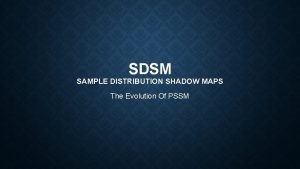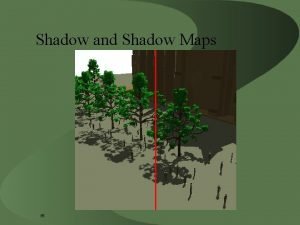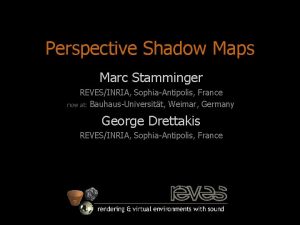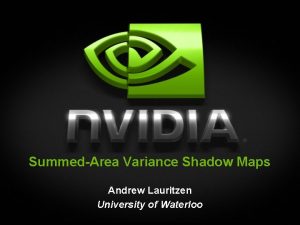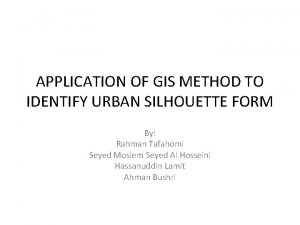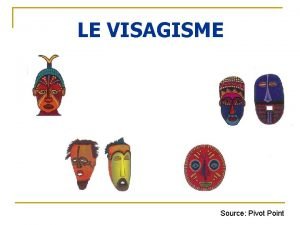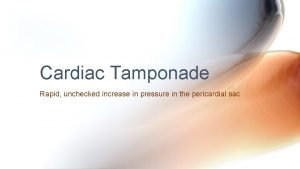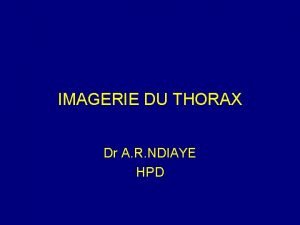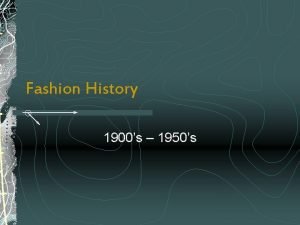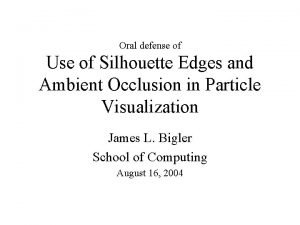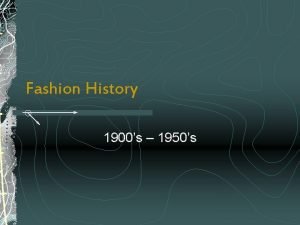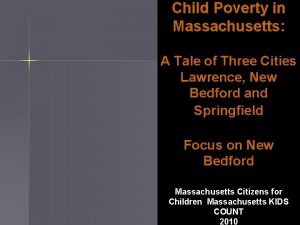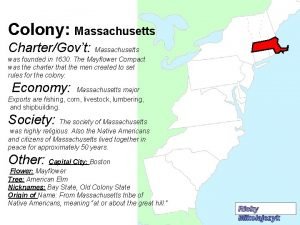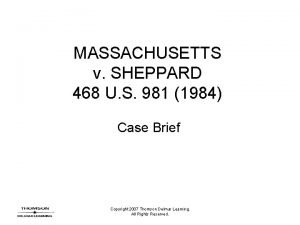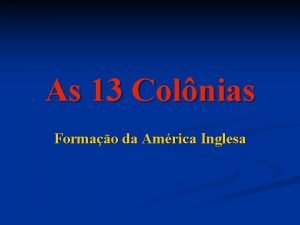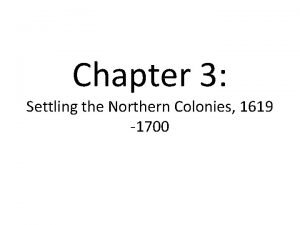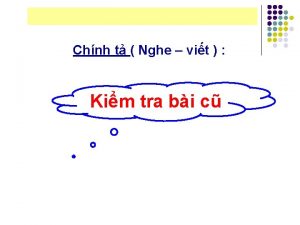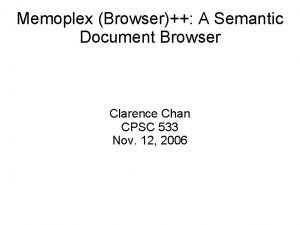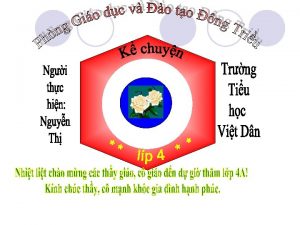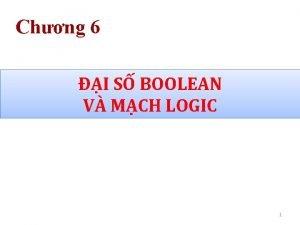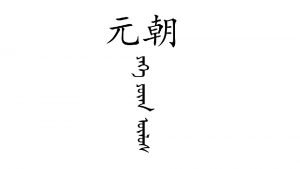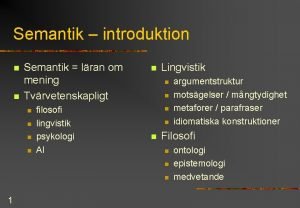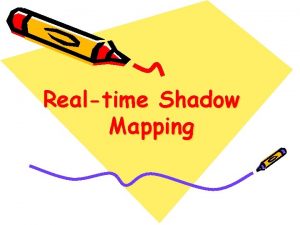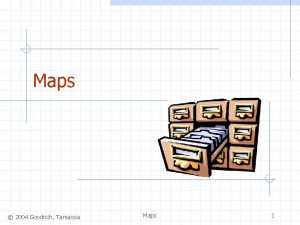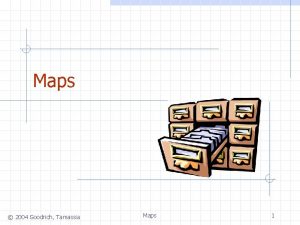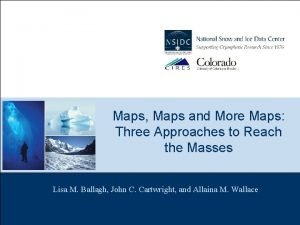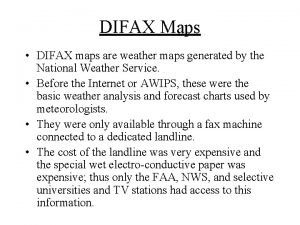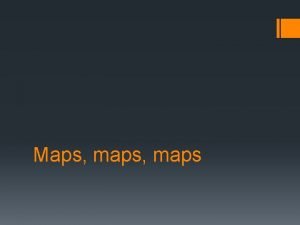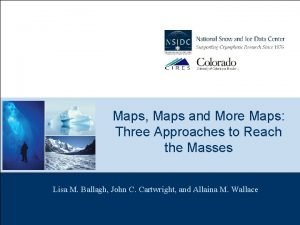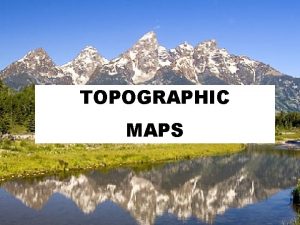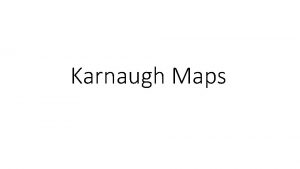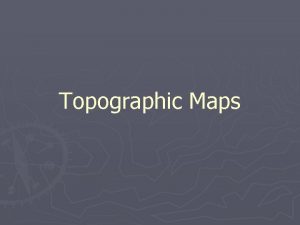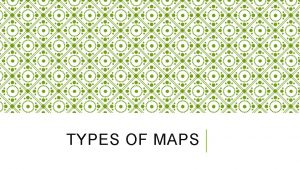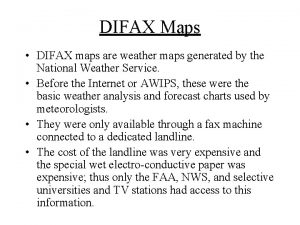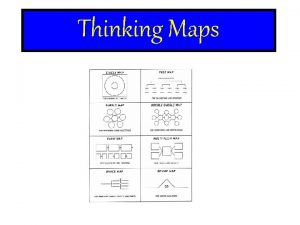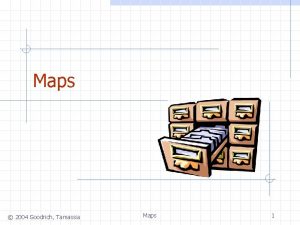Shadow Silhouette Maps Eric Chan Massachusetts Institute of








































































































- Slides: 104

Shadow Silhouette Maps Eric Chan Massachusetts Institute of Technology

Game Plan Motivation Algorithm Implementation Examples Comparison

Motivation Why another shadow algorithm? Why not use perspective shadow maps? Stamminger and Drettakis, SIGGRAPH 2002

Perspective Shadow Maps Addresses perspective aliasing Optimizes distribution of depth samples Difficulties: • Does not handle projection aliasing • Dueling frusta problem

Dueling Frusta Problem

Shadow Silhouette Maps • Research at Stanford University – P. Sen, M. Cammarano, and P. Hanrahan – Proceedings of SIGGRAPH 2003 • See course notes • Also available online

Observation Shadow maps • undersampling can occur anywhere • artifacts visible only at shadow edges

How To Fix Silhouettes? One solution: • use a better silhouette approximation depth map silhouette map

Shadow Map (Review) light source blocker receiver

Shadow Map (Review) depth map

Shadow Map (Review) depth map

Shadow Map (Review) depth map

Depth Mesh depth mesh (sampling grid)

Depth Mesh original grid (blue) dual grid (red) depth mesh + dual mesh

Depth Mesh original grid (blue) dual grid (red) discrete silhouette boundary depth mesh + dual mesh

Depth Mesh original grid (blue) dual grid (red) discrete silhouette boundary continuous silhouette boundary (green) depth mesh + dual mesh

Depth Mesh original grid (blue) dual grid (red) discrete silhouette boundary continuous silhouette boundary (green) silhouette map pixels depth mesh + dual mesh

Depth Mesh Deformation Move depth samples to lie on silhouette curve deformed depth mesh

Depth Mesh Deformation adjusted depth samples deformed depth mesh

Depth Mesh Deformation adjusted depth samples deformed depth mesh

Better Approximation piecewise-linear approximation

Silhouette Map deformed depth map Decomposition of deformed depth map silhouette map

What is a Silhouette Map? Many ways to think about it: • Edge representation • 2 D image, same resolution as depth map • Offset from depth map by ½ pixel in x, y • Stores xy-coordinates of silhouette points • Stores only one silhouette point per texel • Piecewise-linear approximation

Algorithm

Algorithm Properties • Scalable • Treats perspective and projection aliasing • Supports dynamic scenes • Maps to graphics hardware

Algorithm Overview Image-space algorithm

Algorithm Overview Step 1 Create depth map

Algorithm Overview Step 2 Create silhouette map

Algorithm Overview Step 3 Render scene and shadows

Algorithm Details • Focus now on concepts • Worry later about implementation ?

Create Depth Map Same as in regular shadow maps

Identify Silhouette Edges Find object-space silhouettes (light’s view)

Create Silhouette Map • Rasterize silhouette edges (light’s view) • Find points that lie on silhouette edges • Store one such point per texel silhouette edges silhouette points

Compute Silhouette Points Example: point of view of light silhouette edges

Compute Silhouette Points silhouette map (dual grid)

Compute Silhouette Points rasterization of silhouettes

Compute Silhouette Points rasterization of silhouettes pick an edge

Compute Silhouette Points rasterization of silhouettes rasterize edge conservatively: be sure to generate fragments for silhouette pixels

Compute Silhouette Points rasterization of silhouettes for each fragment: pick a point on the edge

Compute Silhouette Points rasterization of silhouettes silhouette points

Compute Silhouette Points rasterization of silhouettes do the same for other edges

Compute Silhouette Points rasterization of silhouettes completed silhouette map subtle issues: • only one point per texel • new values overwrite old ones how to pick silhouette points?

Picking Silhouette Points Pick a point on the line that lies inside the texel ?

Silhouette Point Algorithm Case 1: vertex inside

Silhouette Point Algorithm Case 1: vertex inside pick the vertex itself

Silhouette Point Algorithm Case 1: Case 2: vertex inside one intersection test for intersection against two diagonals

Silhouette Point Algorithm Case 1: Case 2: vertex inside one intersection pick the intersection point itself

Silhouette Point Algorithm Case 1: Case 2: vertex inside one intersection Case 3: two intersections

Silhouette Point Algorithm Case 1: Case 2: vertex inside one intersection Case 3: two intersections use midpoint

Silhouette Point Algorithm Case 1: Case 2: vertex inside one intersection Case 3: Case 4: two intersections no intersections

Silhouette Point Algorithm Case 1: Case 2: vertex inside one intersection Case 3: Case 4: two intersections no intersections

Render scene How to compute shadows? Split problem into two parts: • non-silhouette pixels: use shadow map • silhouette pixels: use silhouette map

Find Silhouette Pixels • Project sample into light space • Compare depth against 4 nearest samples in shadow map samples sample to be shaded (projected to light space)

Find Silhouette Pixels results agree: non-silhouette pixel S S

Find Silhouette Pixels Case #1 Case #2 results agree: non-silhouette pixel results disagree: silhouette pixel S S S L

Treat Non-Silhouette Pixels Easy: use depth comparison result in shadow illuminated S S L L

Treat Silhouette Pixels Reconstruct edge using silhouette map fetch five silhouette points S L

Treat Silhouette Pixels Reconstruct edge using silhouette map splits cell into four quadrants S L

Treat Silhouette Pixels Shade sample according to quadrant example: sample in shadow S L

Six Combinations (1 of 6) S S

Six Combinations (2 of 6) S S S L S S

Six Combinations (3 of 6) S S S L

Six Combinations (4 of 6) S S S L L S

Six Combinations (5 of 6) S S S L S L L

Six Combinations (6 of 6) S S S L S L L L L

Algorithm Recap Image-space algorithm

Algorithm Recap (1 of 3) Create depth map Easy: just like regular shadow map

Algorithm Recap (2 of 3) Create silhouette map Rasterize silhouette edges Pick silhouette points, 1 per texel

Algorithm Recap (3 of 3) Render scene and shadows Fetch local silhouette points Reconstruct shadow edge

Implementation

Implementation • Details (Open. GL) • Hardware acceleration • Optimizations

Create Shadow Map Render to standard Open. GL depth buffer Optimizations • for closed models, cull back faces • turn off shading, color writes • only send vertex positions • draw roughly front-to-back

Create Silhouette Map Goal: store points that lie on silhouette

Initialize Silhouette Map Place default point at texel center default silhouette point silhouette map texel use gl. Clear(. . . )

Create Silhouette Map Fragment program finds silhouette point

Create Silhouette Map Fragment program finds silhouette points • use local coordinates • store only xy offsets (0, 1) (1, 1) (0. 6, 0. 3) (0, 0) (1, 0)

Rasterizing Silhouettes Two issues: • must guarantee generation of silhouette pixels • discard occluded silhouettes

Rasterizing Silhouettes Rasterize conservatively • Be careful using Open. GL wide lines • Use width of at least 3 gl. Line. Width(3); • Make lines slightly longer to cover endpoints Another solution: use thin quads, not lines • See Sen et al. [SIG 2003] paper

Occluded Silhouette Pixels Example: don’t draw these!

Occluded Silhouette Pixels Implementing occlusion: • Use depth map from first pass • Recall silhouette map offset by ½ pixel • Use fragment kill if depth is greater than 4 nearest samples ? in depth map ? ? ?

Rendering Final Image Recall • • Draw from observer’s view Identify silhouette vs. non-silhouette pixels Use shadow map for non-silhouette pixels Use silhouette map for silhouette pixels

Silhouette Reconstruction Use a fragment program to compute the shadows sample point

Silhouette Reconstruction Fetch silhouette points • 1 interior point • 4 neighbors silhouette points

Silhouette Reconstruction Fetch silhouette points • 1 interior point • 4 neighbors Create eight wedges

Silhouette Reconstruction Fetch silhouette points • 1 interior point • 4 neighbors Create eight wedges Find enclosing wedge • point-in-triangle tests

Silhouette Reconstruction S L Fetch silhouette points • 1 interior point • 4 neighbors Create eight wedges Find enclosing wedge • point-in-triangle tests S L Shade the sample using wedge’s depth test result

Silhouette Reconstruction S L Fetch silhouette points • 1 interior point • 4 neighbors Create eight wedges Find enclosing wedge • point-in-triangle tests S L Shade the sample using wedge’s depth test result Repeat for all samples

Optimizations Fragment program is expensive • lots of arithmetic • lots of texture reads (5 silhouette points) However, only required for silhouette pixels!

Optimizations Very few silhouette pixels in practice original scene silhouette pixels (1% total image)

Optimizations Use fragment program branching • Potentially huge performance wins • Only available in latest hardware

Examples and Analysis

Example 1 shadow maps shadow volumes silhouette maps

Example 1 (closeup) shadow maps shadow volumes silhouette maps

Example 2 shadow maps

Example 2 projected silhouette map

Example 2 shadows using silhouette map

Quality Comparison shadow map silhouette map

Artifacts • Silhouette map: one point per texel • Multiple edges inside a texel

Artifacts shadow maps shadow volumes silhouette maps

Artifacts (closeup) Artifacts due to multiple edges More noticeable when animated shadow maps shadow volumes silhouette maps

Algorithm Comparison Perspective Shadow Maps: • same generality as shadow maps • minimal overhead (2 passes) • doesn’t address aliasing in all cases Shadow Silhouette Maps: • addresses aliasing more generally • more overhead (3 passes + big shaders) • less general than shadow maps

Combination of Algorithms Why not combine techniques? Perspective shadow map: • Optimizes depth sample distribution • More samples closer to viewer Shadow silhouette map: • Optimizes depth sample information • Exact silhouette edge locations

Summary • • Image-space algorithm Silhouette map: deformed depth map Piecewise-linear approximation Scalable Compared to (perspective) shadow maps: • Removes aliasing in more cases • Additional overhead and requirements

 Interior points
Interior points Bé thì chăn nghé chăn trâu
Bé thì chăn nghé chăn trâu Sample distribution shadow maps
Sample distribution shadow maps Shadow maps
Shadow maps Stumour
Stumour Perspective shadow maps
Perspective shadow maps Variance shadow mapping
Variance shadow mapping Device driver does not support hardware shadow maps
Device driver does not support hardware shadow maps Reittihaku google maps
Reittihaku google maps Urban silhouette
Urban silhouette Profil concave visage
Profil concave visage Enlarged cardiac silhouette
Enlarged cardiac silhouette Silhouette portrait 3 amazon
Silhouette portrait 3 amazon Silhouette cardio-thymique
Silhouette cardio-thymique Signe de la silhouette
Signe de la silhouette Portrait zentangle
Portrait zentangle Vibinet
Vibinet S shaped silhouette
S shaped silhouette A rose for emily setting
A rose for emily setting éctasique
éctasique Silhouette edges
Silhouette edges Shape color texture
Shape color texture S-curve silhouette
S-curve silhouette Marlene sallo
Marlene sallo Data privacy massachusetts
Data privacy massachusetts Thomas barnard sermon massachusetts 1763
Thomas barnard sermon massachusetts 1763 Project impact massachusetts
Project impact massachusetts Pearson access next mcas
Pearson access next mcas Massachusetts office of travel & tourism
Massachusetts office of travel & tourism Famous massachusetts landmarks
Famous massachusetts landmarks Hdap insurance
Hdap insurance Massachusetts work based learning plan
Massachusetts work based learning plan What is considered new england
What is considered new england Massachusetts food code
Massachusetts food code Pay equity massachusetts
Pay equity massachusetts Massachusetts higher education consortium
Massachusetts higher education consortium Efile massachusetts appeals court
Efile massachusetts appeals court Massachusetts timesheet
Massachusetts timesheet Massachusetts educational financing authority
Massachusetts educational financing authority Massachusetts department of motor vehicle
Massachusetts department of motor vehicle Open loop geothermal well massachusetts
Open loop geothermal well massachusetts Cvte massachusetts
Cvte massachusetts University of massachusetts building authority
University of massachusetts building authority Massachusetts association for professional law enforcement
Massachusetts association for professional law enforcement Massachusetts renewable portfolio standard
Massachusetts renewable portfolio standard Renewable energy massachusetts llc
Renewable energy massachusetts llc Hdmaster massachusetts
Hdmaster massachusetts Chapter 766 massachusetts law
Chapter 766 massachusetts law Dsrip massachusetts
Dsrip massachusetts Medication administration program massachusetts
Medication administration program massachusetts Child poverty in massachusetts
Child poverty in massachusetts Cfma massachusetts
Cfma massachusetts Danny townsend massachusetts
Danny townsend massachusetts Mayflower compact image
Mayflower compact image Hcsis massachusetts
Hcsis massachusetts Adrc massachusetts
Adrc massachusetts From massachusetts
From massachusetts Body: massachusetts comprehensive assessment system
Body: massachusetts comprehensive assessment system Massachusetts v sheppard
Massachusetts v sheppard Sample iep for 4 year old
Sample iep for 4 year old Concept paper example
Concept paper example Restraint training massachusetts
Restraint training massachusetts Joseph smith salem massachusetts
Joseph smith salem massachusetts Massachusetts mandatory reporting
Massachusetts mandatory reporting Rural development loan massachusetts
Rural development loan massachusetts Província da baía de massachusetts
Província da baía de massachusetts Dominant religious group in massachusetts bay
Dominant religious group in massachusetts bay Solar massachusetts renewable target (smart) program
Solar massachusetts renewable target (smart) program Mỹ thuật lớp 3 chân dung biểu cảm
Mỹ thuật lớp 3 chân dung biểu cảm Nằm cuộn tròn trong chiếc chăn bông ấm áp
Nằm cuộn tròn trong chiếc chăn bông ấm áp Chan hellman
Chan hellman Dr keith chan
Dr keith chan Bernice chan
Bernice chan Dừng chân nghỉ lại nha trang
Dừng chân nghỉ lại nha trang Qun hong chan
Qun hong chan Kefe analizi
Kefe analizi Chan semantik
Chan semantik Marsha chan
Marsha chan Lilian chan hku
Lilian chan hku Jackie chan in latvia
Jackie chan in latvia Chan kim blue ocean strategy
Chan kim blue ocean strategy Ozaku chan
Ozaku chan Chan kheng hoe
Chan kheng hoe Xương ụ ngồi
Xương ụ ngồi Vincent chan mit
Vincent chan mit Chan browser
Chan browser Một nhà thơ chân chính
Một nhà thơ chân chính Amy leung md
Amy leung md Wake forest career services
Wake forest career services Bảng chân trị xor
Bảng chân trị xor Dr alan chan
Dr alan chan Mapa imperium mongolskiego
Mapa imperium mongolskiego Blefaroespamo
Blefaroespamo Chi
Chi Chan semantik
Chan semantik Helene chan
Helene chan Bayraktar-chan
Bayraktar-chan Sơ đồ chân arduino nano
Sơ đồ chân arduino nano đường và chân là đôi bạn thân
đường và chân là đôi bạn thân Chan ho mun
Chan ho mun Dr alan chan
Dr alan chan Kung fu master
Kung fu master Doctor paul chan
Doctor paul chan Dr chan yan fat alfred
Dr chan yan fat alfred Dr jacqueline chan
Dr jacqueline chan


